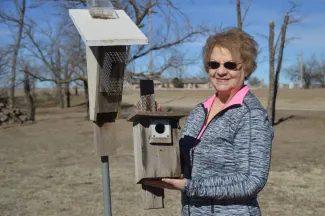Just west of Elk City, is a bluebird’s paradise. Pastures brim with insects, scattered trees offer branches from which to perch and hunt, and a trail of bird houses is waiting should the birds decide to build a nest. This oasis is no accident; Ann Freeman and her husband have been maintaining these bluebird boxes, 20 in all, for 29 years.

“I remember the first time I saw a bluebird,” said Freeman. “It was about nine years after I had gotten married and moved west of town. One September day, I saw a group of the blue birds in the trees. The birds would perch in the trees and then fly to the ground. I had no idea what type of birds they were.”
She called her parents who lived nearby to see the brightly-colored birds. “After we watched the birds, I spoke with the lady who wrote a bird column in the newspaper. She told me I must have bluebirds.”
From there, she researched the songbird and learned their natural nesting spot was an old woodpecker hole and that the birds and their nesting trees were getting pretty scarce. She also learned the birds would readily use man-made nest boxes and of a program to monitor their nests.
“That first year, my dad and I built five or six boxes. We had a pair of birds use a box the next season and we fledged one little bluebird. We were hooked,” Freeman said.
Since that first bluebird chick, the Freeman’s have counted as 2,389 other bluebird chicks have left the nest. At the end of each season, the family has reported the total number of eggs, chicks and fledged birds to the Oklahoma Department of Wildlife Conservation’s Nest Box Trails program.
“We check the boxes about every five days. It takes about an hour to check them all,” she said. “Most of the time we drive to the different boxes, but my husband will occasionally walk the trail.”
Over the years, family members have helped monitor the nest boxes. “Our granddaughters have been our ‘secretaries.’ They like to write down what we see in the boxes,” Freeman said.
In addition to counting the number of eggs or chicks each box houses, the Freeman’s are also monitoring for anything that may harm the bluebirds. “Bluebirds have a lot of enemies, so it is important to be dedicated to checking the boxes.”
The Freeman’s have found snakes crawling up the poles and have lost nests because of ants, but their largest problem is the nonnative house sparrow.
“It’s pretty easy to tell a bluebird’s nest from a sparrow’s nest,” she said. “The bluebird builds a tidy cup of grass, but the sparrow will fill the nest box to the top. The sparrows can take over a bluebird’s nest in a matter of days.”
Because the house or “English” sparrow is not protected by law, the Freeman’s are able to remove the sparrow’s nests and trap the nuisance birds. Their efforts have gone a long way to help the blue birds she first noticed nearly 30 years ago.
“It’s a lot of work, but it’s also a joy,” Freeman said. “I can be having a bad day and see a bluebird and it just cheers me up.”